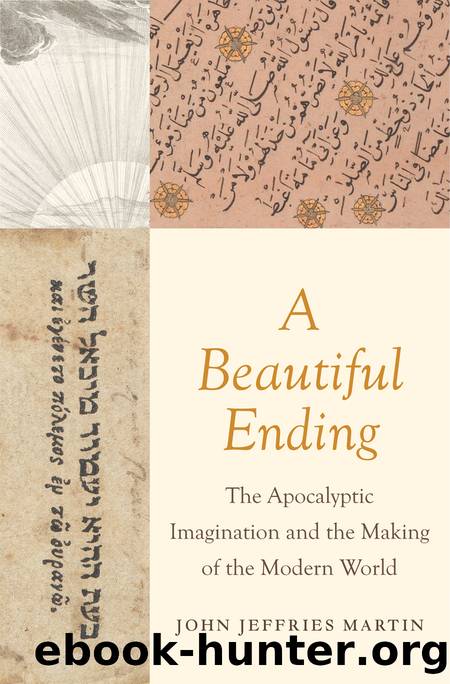A Beautiful Ending by John Jeffries Martin;

Author:John Jeffries Martin;
Language: eng
Format: epub
ISBN: 9780300247329
Publisher: Yale University Press
A Christian globe. This map, one of a series illustrating a manuscript from late fifteenth-century Germany, is a cartographic prophecy. After earlier maps that portrayed Christendom under siege first from Islam and then from the Antichrist, this one portrays a future when Christianity would prevail, preparing the way âunder one flock and one shepherdâ for the End of Time.
At the beginning of the fifteenth century, an ancient Greek text was translated into Latin and began to circulate in western Europe, at first in manuscript and then later in printed and even illustrated editions.8 To be sure, medieval scholars had always had an indirect knowledge of Ptolemyâs Geography. But it was through the recovery and translation of this text into Latin that scholars in the late Middle Ages and the Renaissance, among them Pierre dâAilly, first grasped the power of Ptolemyâs method for calculating latitude and longitude as well as the value of his method for projecting the three-dimension spherical shape of the earth onto the two-dimensional surface of a map that he and his followers called a planisphere. The second printed edition of his text, published in Bologna in 1477, included such a map, one that made the power of the Ptolemaic projection evident. The reader was now gazing down, as if a god, on the surface of a world mapped with mathematical precision. Even if there were errors in Ptolemyâs map, cartographers understood quickly that what mattered were not Ptolemyâs particular claims but rather a model of the world that enabled them to continue to correct and refine their maps.
By its very nature, that is, Ptolemyâs Geography made it possible both to display what was known and to invite continuous updatings, as reports of new discoveries poured into the ateliers of silversmiths, engravers, and printers who worked alongside the cartographers and cosmographers of the age. Moreover, in these displays, early modern men and women could trace the extraordinary speed with which their world picture was changing. Ptolemyâs planisphere of 1477 portrayed the then three known continents and famously depicted the Indian Ocean as landlocked, unreachable from the Atlantic. Then, on the basis of Bartolomeu Diasâs discovery of the Cape of Good Hope in 1488, Martin Behaimâs Erdapfelâthe first surviving terrestrial globe, produced in Nuremberg in 1492, just as Columbus was embarking on his first voyageâshowed that it would be possible to reach the Indian Ocean by sailing south along the African coast. In 1507, inspired by Vespucciâs Letters, Martin Waldseemüller explicitly included a fourth continent, which he baptized âAmericaâ in his Universalis cosmographia. To be sure, the understanding of America and its relation to Asia was still not entirely clear. Franciscus Monachusâs double-hemisphere map of the world, published in about 1527, conjoined North America to Asia.9
Not surprisingly, in such an environment maps and globes became objects of fascination, introducing a new but always evolving âworld pictureâ to a society undergoing a period of rapid change and astonishing discoveries. More than any other objects of the early modern period, globes and planispheres became proxies of the idea that knowledge itself was always incomplete.
Download
This site does not store any files on its server. We only index and link to content provided by other sites. Please contact the content providers to delete copyright contents if any and email us, we'll remove relevant links or contents immediately.
| Ancient & Classical | Arthurian Romance |
| Beat Generation | Feminist |
| Gothic & Romantic | LGBT |
| Medieval | Modern |
| Modernism | Postmodernism |
| Renaissance | Shakespeare |
| Surrealism | Victorian |
4 3 2 1: A Novel by Paul Auster(11788)
The handmaid's tale by Margaret Atwood(7447)
Giovanni's Room by James Baldwin(6808)
Asking the Right Questions: A Guide to Critical Thinking by M. Neil Browne & Stuart M. Keeley(5355)
Big Magic: Creative Living Beyond Fear by Elizabeth Gilbert(5351)
Ego Is the Enemy by Ryan Holiday(4956)
On Writing A Memoir of the Craft by Stephen King(4662)
The Body: A Guide for Occupants by Bill Bryson(4581)
Ken Follett - World without end by Ken Follett(4443)
Bluets by Maggie Nelson(4261)
Adulting by Kelly Williams Brown(4232)
Eat That Frog! by Brian Tracy(4149)
Guilty Pleasures by Laurell K Hamilton(4116)
White Noise - A Novel by Don DeLillo(3829)
The Poetry of Pablo Neruda by Pablo Neruda(3814)
Fingerprints of the Gods by Graham Hancock(3738)
Alive: The Story of the Andes Survivors by Piers Paul Read(3730)
The Book of Joy by Dalai Lama(3697)
The Bookshop by Penelope Fitzgerald(3619)
